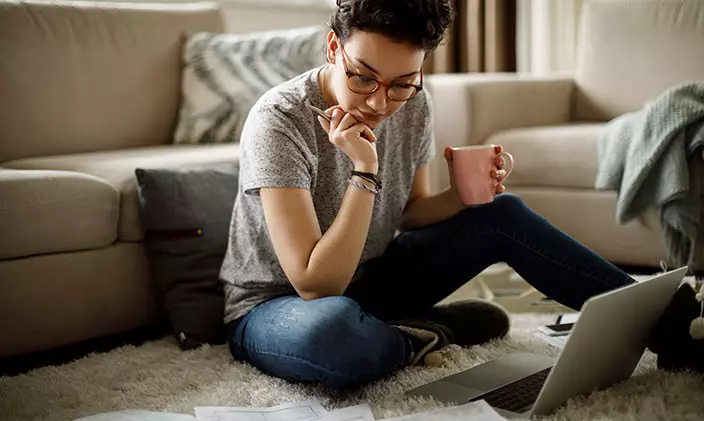What is blended learning?

Written by Michael Feder

Reviewed by Christina Neider, EdD, Associate Provost of Colleges

Blended learning, sometimes called “hybrid learning,” is the mixture of digital or online learning with more traditional, in-classroom instructional techniques. As a practice, this has also been called a “flipped classroom.” The difference in terms describes approaches to integrating technology — but they all have technology as a core or supplemental aspect of the classroom.
This instructional method took off in 2007 when two chemistry professors were looking for better ways to deliver educational materials to students who missed class. They started to “pre-broadcast” and publish the materials that would accompany the lecture on a YouTube channel available to students. They noticed an increase in students’ active engagement in materials and classes after this.
Since then, blended learning has become more popular as technology has become more common in the classroom. The COVID-19 pandemic, in particular, vastly increased the demand for the blended model as schools shut down in-person classes, and teachers had to deliver completely online classes.
Even after schools returned to their usual capacity, some teachers maintained their blended modules for a variety of reasons. For one, it empowers students to take ownership of their education since they have control of how fast and how often to access materials rather than learning through a method and at a pace over which they have no say. In a three-year study, 89% of teachers saw an increase in self-directed student learning after using these techniques.
There are several types of blended learning models that can help improve student learning experiences as well as outcomes that have become a more common part of curricula in modern teaching and education degree programs.
6 models of blended learning in education
Teachers might employ many different methods of blended learning; each can be helpful to learners in a variety of situations.
Enriched virtual
Enriched virtual is an alternative to full-time online education and only requires student attendance infrequently as a majority of the learning takes place online. For example, in-person attendance may be required twice weekly rather than five days. This could be scaled even further out for college-level classes, such as bimonthly.
Enriched virtual is one of the most flexible models for students and teachers, but it also encourages students to be almost entirely independent during their learning time. The model can be great for students who work at a different pace than others in their classroom.
At a higher education level, this model can provide students with the time to work or care for children. The success of this model depends on two things — a student’s ability to complete work at home and comprehensive education modules that are primarily designed for online students.
Rotation (station, individual and lab)
The rotation model involves rotating students from different stations on a fixed schedule. For example, students may spend their day going between online modules, lectures and collaborative activities. This model is most common in elementary schools and is one of the most popular blended-learning models overall.
The rotation model encourages individual learning while still offering teacher oversight and classmate collaboration. Rotation is especially effective for younger students who are still developing socialization skills.
Face-to-face driver
In the face-to-face driver model, online learning supplements in-person learning. While in-person learning is the backbone of the classroom, the instructor chooses when to add in e-learning elements. This model is the closest to a traditional classroom.
Face-to-face driver may be ideal for students with special needs. For example, English-language learner students or those with developmental or physical needs, such as difficulty hearing, can benefit from in-person instruction backed up by specialized e-learning modules that serve their needs.
Online driver (flipped classroom)
This model can be seen as the opposite of the face-to-face driver. The instructor chooses when to supplement online modules with face-to-face instruction. However, unlike the enriched virtual model, face-to-face check-ins are optional. This is great for students who want to work at their own pace or need to work around prior commitments.
Online-only college programs are some of the most common academic institutions that use this model.
Students who often travel, such as in military families, may also find the online driver model effective. Parents might view this option as a suitable alternative to homeschooling, where they can monitor their child’s education but still have the support of qualified educators. Online driver is a more niche blended learning model, but students can still access it if they seek out the right programs.
Self-blend
The self-blend learning model allows students to decide when to integrate e-learning into their education. This could be in the form of advanced placement courses or prep courses for standardized tests.
It’s important to note that students are still expected to attend in-person classes in accordance with class attendance policy, regardless of whether they are self-blending. They may talk to the educator to negotiate exceptions, but this will have to be arranged on a case-by-case basis.
Flex
This model lets students and teachers choose from the aforementioned models or even do a mix of them. Choosing the model that will best facilitate learning for the student’s individual needs and learning style is incredibly important for classroom success and student empowerment. Flex models require communication between students, teachers and parents to create a successful lesson plan.
Blended learning in the classroom
How these models are applied depends largely on the makeup of a classroom. Elementary school students, for instance, generally interact with this type of learning differently than students in college.
Understanding how this type of learning can find its way into a variety of classrooms can provide a more comprehensive understanding of the concept, and better communicate its strengths in modern education.
Elementary
While elementary school students are not generally seen as independent learners, the blended approach can provide them with the opportunity to develop the skills necessary to learn independently.
As stated, the rotation model is the one most seen in elementary school classrooms. Instead of rows of desks in front of a lecturing teacher, this type of classroom tends to be more spread out. Students move through stations, each focusing on different aspects of a broader lesson. They may perform different activities, watch educational videos or fill out worksheets at each station, advancing to the next at their own pace.
This model allows teachers to better see where students succeed and where they may be struggling. While some students advance quickly through the stations, others may struggle at a particular point. If many students struggle at one station, teachers can collect the class together for a lesson addressing the problem.
High school
Many high schools in the U.S. incorporate blended models, some incorporating technology more than others. At the most extreme, some high schools are entirely remote and allow students freedom to move through the curriculum at their own pace.
To take a real-world example, the Kentucky Department of Education launched a blended program in January 2007 at 42 schools. As part of the pilot, math students spent three weekdays learning in a traditional classroom. For the other two days, they worked in a computer lab, completing online coursework with their teacher there to help.
This model can help prepare students with the skills they will need in higher education, where independent learning will be required. In addition, the blended model can prove to be more flexible for students with different learning styles.
College
It’s no wonder that blended learning found its first success in a college chemistry classroom. College students generally possess the ability and will to pursue their education without constant supervision and instruction. Often short on time, college students may prefer to shift much of their workload to virtual platforms, leaving in-person education to lessons that require in-person attendance.
In a blended model, college students can access teacher lectures and study material remotely and on their own time. This can be useful for a student who misses a lecture or who just wants to go back over anything they might have missed. Some professors may choose to shift their lectures entirely to virtual, freeing up time in class for group discussions and experiments.
How teachers can transition to a hybrid or blended learning environment
Although it inevitably allows a level of empowerment, flexibility and ease, blended learning does not deliver these benefits automatically without teachers. Especially during the adjustment period between a traditional classroom and a blended environment, teachers should work closely with students and parents. Providing clear instruction and expectations is a great start to reducing confusion and getting everyone on the same page.
If you’re an educator who has never worked in a blended classroom or are simply looking to sharpen your skills, then getting an EdTech certificate could provide an important foundation. Educational technology as a concept isn’t new; however, as trends change and technology grows more sophisticated, it’s important to stay abreast of new trends, both through independent research and continuing education.
Blended learning grows more and more popular as technology becomes an integral part of everyday lives. For a long time, the question of how teachers can improve student outcomes has been a topic of interest, both for those directly involved in education and those outside of it. As more classrooms make the transition, more information will be made available to discern the positives and negatives of these methods.
Want to strengthen your foundation as an educator? Learn more about education degrees from UOPX.

ABOUT THE AUTHOR
A graduate of Johns Hopkins University and its Writing Seminars program and winner of the Stephen A. Dixon Literary Prize, Michael Feder brings an eye for detail and a passion for research to every article he writes. His academic and professional background includes experience in marketing, content development, script writing and SEO. Today, he works as a multimedia specialist at University of Phoenix where he covers a variety of topics ranging from healthcare to IT.

ABOUT THE REVIEWER
Christina Neider is the associate provost of colleges and former dean of the University of Phoenix College of Social and Behavioral Sciences. Neider’s career spans more than 30 years in academia, healthcare and the U.S. Air Force. She has held several academic leadership roles at University of Phoenix, and she is the Vice President of membership for the Arizona Chapter of the Healthcare Information and Management Systems Society.
This article has been vetted by University of Phoenix's editorial advisory committee.
Read more about our editorial process.


